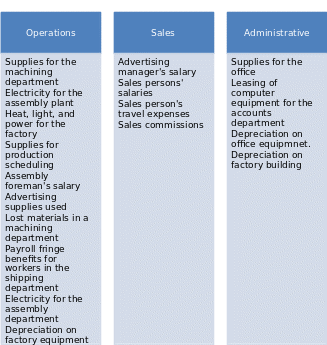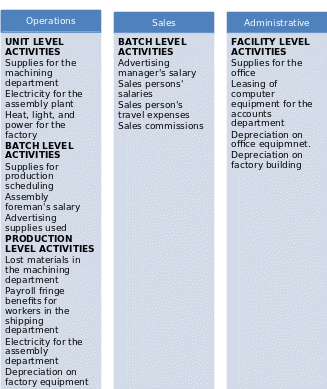Identification of Costs in Relation to the Relevant Divisions
Glaser Health Products is organized into three main divisions. The three include operations, sales, and administrative. According Gary and Sorinel (2010), each of these divisions is associated with a set of functions. The success of business operations at Glaser Health Products depends on the interaction between the various organs.
To this end, it is noted that the three divisions have their own unique roles contributing towards the running of the organization. For effective financial and operations management, each of the departments is assigned a number of cost categories. Figure 1 is an illustration of the specific cost classifications associated with the respective functions of each of the departments mentioned above.

Costing and cost analysis are carried out in relation to the functions of a given department. For instance, the category referred to as “supplies to the office” falls under the administrative division. According to Gary and Sorinel (2010), this form of grouping is needed to ensure that resources available to the firm are properly utilized. As a result, it is easy to keep track of the costs incurred by each of the departments.
Activity-Based Costing at Glaser Health Products
The functions of a company are enhanced once the respective cost groupings are clustered according to the respective categories identified by the management. Prabhu, Booth, Teemu, and Brown (2009) propose that activity based costing is suitable for such situations. The parameters used in this form of costing at Glaser Health Products are grouped on the basis of the following levels:
- Unit level activities.
- Batch level activities.
- Product level activities.
- Facility level activities.
Figure 2 illustrates the basis on which the activities are categorized. In light of this, it is noted that the cost clusters can be ranked on the strength of specific activities. According to Gary and Sorinel (2010), the functions mentioned above are essential to the operations of the firm. They ensure that the budgetary allocations are properly and clearly outlined.

Figure 2 is an indication of the proposed clustering of the activities using the format of activity levels. The classification is conducted in relation to the divisions at Glaser Health Products. Gary and Sorinel (2010) hold the opinion that each division in the company is characterized by the 4 factors highlighted above. The activity levels give each department a structured approach to costing.
Glaser Health: Appropriate Cost Driver
It is noted that unit level activity requires a volume based cost driver. Gary and Sorinel (2010) support these sentiments by arguing that the units produced determine the amount of activity involved. The two (units produced and level of activity) are seen to be directly proportional. According to Gary and Sorinel (2010), batch level activity comes into play when a new consignment of items is produced by the company. To this end, the appropriate cost driver would be related to the set-up time (Gary & Sorinel, 2010).
Product level activity is based on the production of a given commodity. The relationship between activity and production remains regardless of the number or nature of batches generated. In light of this, it is noted that sustenance is the appropriate cost driver for this activity (Gary & Sorinel, 2010). Finally, the homogenous pool of costs is best suited for facility level activities. The magnitude of the undertakings involved in this case determines the selection of the homogenous pool. The company should take this into consideration for effective management of costs.
Tracing Individual Items of Cost to Activity Groupings
Individual items of cost can be traced down to activity groupings through a system developed specifically for this purpose. The model used is referred to as activity based costing (ABC). According to Gary and Sorinel (2010), ABC is associated with a number of advantages. One of them is the fact that it helps the company to ensure that each of the activities carried out in the firm are adequately accounted for in terms of costs. The first step in tracking down individual items of cost involves clustering. To this end, costs are categorized depending on their respective functions in the company.
As illustrated in Figure 1, one can determine the actual costs based on the budgetary allocations made to that department. In light of this, the ABC highlighted in this paper describes the specifics of a given activity grouping. An accountant will then determine the fairness of the cost settled upon.
Relating Expenditure to Products using Primary Stage Cost Drivers
Primary stage cost drivers are important determinants of the production process. For example, they affect the cost of particular goods or services at the early stages of production. In a study carried out by Prabhu et al. (2009), the ‘operational reasoning’ behind budgets is examined. To achieve this objective, Prabhu et al. (2009) makes reference to costing of products. Prabhu et al. (2009) support their arguments with the help of primary stage cost drivers. Prabhu et al. (2009) argue that the process of creating a link between expenditure and products begins with the identification of the cost object. After this, the accountant can map out the direct costs associated with the object mentioned above.
There are various types of primary stage cost drivers. They include those involved in the allocation of the necessary resources to the production process. Based on this realization, Gary and Sorinel (2010) hold the opinion that the resources involved at the primary stage of production informs the overhead costs. Subsequently, a company can decide on the overhead rate that will be used to develop the cost.
The Importance of Using Preliminary and Primary Cost Drivers: A Case Study of Glaser Health Products
Cost drivers are important determinants of the overall performance of a given company. According to Chiadamron and Wajcharapornjinda (2012), many organizations fail to acknowledge the importance of preliminary and primary cost drivers. Such companies operate with misleading information, something that negatively affects decision making in the firm.
Consequently, the performance of such an organization deteriorates. However, paying attention to the two cost drivers ensures that the company can access reliable information as far as the unit level activities are concerned. When such information is used in planning, the performance of the company improves in the long run.
Preliminary and primary drivers help the organization to control the various costs involved in carrying out operations. The findings made in the study by Prabhu et al. (2009) suggest that it is hard to make the correct cost computations without information on the two cost factors. Companies can improve their calculation methods by taking into consideration the import of primary and preliminary cost drivers. The two provide the accountant with tangible information on the initial production of commodities.
References
Chiadamron, N., & Wajcharapornjinda, P. (2012). Developing an economic cost model for quantifying supply chain costs. International Journal of Logistics Systems and Management, 13(4), 540-571.
Gary, C., & Sorinel, C. (2010). Cost drivers: Evolution and benefits. Theoretical and Applied Economics, 18(8), 7-16.
Prabhu, S., Booth, P., Teemu, M., & Brown, D. (2009). An exploratory study on the reasons to budget. Accounting & Finance, 49(4), 849-871.